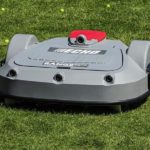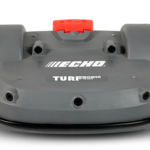A “Roomba” with a view
January 31, 2020
The 2020 PGA Merchandise Show in Orlando, FL last week was another huge celebration of everything golf. According to the folks who ran it, about 40,000 attendees from every U.S. state and 80 other countries filled the Orange County Convention Center’s West Concourse for three days, preceded the day before at Orange County National Golf Center for a cold, blustery Demo Day.
I was one of more than 1,000 participants with media credentials to cover all this stuff as best we could. I conducted over 30 interviews with a wide variety of golf businesses. The results of those conversations will be shared here throughout the coming year.
Because I have been there and done that for several years, I was able to meet and greet several golf reps with whom I’ve worked previously. There were also many opportunities to meet new Show participants or discover some whose wares I had missed.
For example, I enjoyed meeting Joe Fahey, vice president of Echo Robotics of Lake Zurich, IL, to learn about the company’s robotic range ball picker with its larger partner, a robotic range mower.

RP-1200 ball picker
Think of Roomba-style vacuums, but on a very large scale.
The RP-1200 is nearly square in size, about 4 feet each way, and stands a bit more than 1.5 feet high. With the batteries installed it weighs 188 pounds. The machine ambles along at 2.2 mph, a slow walking pace for humans. Sensors tell it to take a break after loading 300 balls using plastic roller/grabbers, clearing a swath about 40 inches wide with each pass.
The machine then rolls over to a prepared offloading area, tips over to empty its tray, and then strolls back to the range for another load. The RP-1200 can handle 6 acres and up to 12,500 golf balls on a single charge, depending on the layout and any obstacles it must avoid.
Fahey said they recommend placing a 1-inch diameter PVC pipe at each range target flag location, for example. The robots “see” the pipes and move around them.
He said the technology has been in use in Europe for ten years. “They’re used on over 1,500 soccer fields and driving ranges, as well as other spaces,” Fahey said. “These are second generation models, with mechanical upgrades and other improvements in software and safety standards.”
The TM-2000 range mower uses five small rotating and floating disc cutters that clear 40 inches with each pass, at the same 2.2 mph pace. This robot is more rectangular and taller than the range picker, but also lighter at 157 pounds. It can also handle 6 acres of range space with its sensor capabilities.

TM-2000 range mower
Small plastic guards on each cutter disc protect golf balls from the 2-inch long blades just above the guards. “The mower works without cutting or compressing the balls into the ground,” Fahey said.
The machines’ light weights gives range operators the ability to resume operations far more quickly after a heavy rain than when using other, human-operated machines for picking or mowing.
Fahey said the mowers work best when used every day, which helps keep the cut grass from building up too much thatch and harming turf health. He also said the robots can handle terrain with as much as a 17-degree slope. Considering that many ranges use more marginable acreage than the courses they serve, especially in hilly areas, that capability should be sufficient.
The lithium ion batteries run for two hours for every one-hour charge for the mower, with three hours’ run time for every hour’s charge for the range picker.
Use-anywhere software apps in Apple or Google configurations control the devices, with remote commands for GPS locations, real-time status notifications, and monitor performance.
Fahey said they sometimes hear objections that the robots take jobs away, but he disagrees. As he sees it, the machines help address the golf industry’s real problem of labor shortages, and in any event, free up maintenance staff to address other issues on the property while the robots do their thing.
The TM-2000 mower costs about $15,500, while RP-1200 range picker costs $19,000. The projected return on investment should make these attractive options for course and range operators.
As Fahey also suggested, “There’s a cool factor with these robots that fits what some clubs like.”
Publicizing your charity tournaments
Dozens of Cape Region charities or service organizations generate valuable income, both monetary and social, by running golf tournaments from late spring through early fall.
We’re happy to do our part to promote and celebrate this great tradition of blending a fun day out on the course with raising money for good causes.
If you have a golf event coming up, and would like our help to reach potential participants, please send in your tournament information at least one month before the date. That gives most folks enough time to learn about the opportunity and sign up.
Post-event announcements are also fine, including the traditional grip and grin oversize check presentations.
The Thanksgiving Week golf column celebrates the results of all the hard work that goes into these charity events. Your tournament could be one of those included in that piece.

